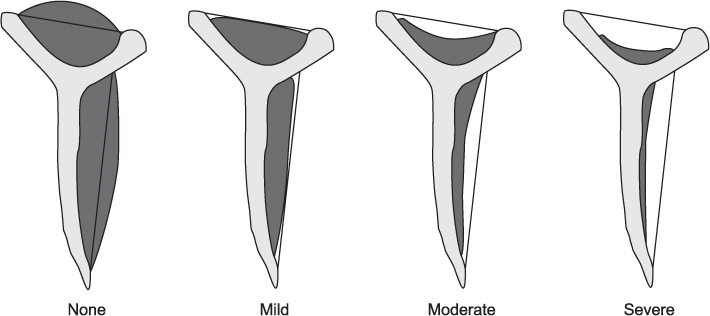J Korean Orthop Assoc.
2013 Feb;48(1):54-60. 10.4055/jkoa.2013.48.1.54.
Massive Tear of the Rotator Cuff
- Affiliations
-
- 1Department of Orthopedic Surgery, Seoul St. Mary's Hospital, School of Medicine, The Catholic University of Korea, Seoul, Korea. kysoos@catholic.ac.kr
- KMID: 2106665
- DOI: http://doi.org/10.4055/jkoa.2013.48.1.54
Abstract
- Massive rotator cuff tear is defined by either a tear size of more than 5 cm or involvement of more than two rotator cuffs. In reality, among Asians, it is almost impossible to find a tear size larger than 5 cm and the latter definition preferred. Most massive rotator cuff tears are chronic and patients usually complain of gradual aggravation of pain or muscle weakness. Exact evaluation of past history along with an appropriate physical examination is necessary for the exact diagnosis and further treatment. As most massive rotator cuff tears are based on chronic factors, not only the tear site, but whole tendon quality may be poor, making anatomical reconstruction difficult. In addition to primary repair of the torn tendon, many other treatment options are available, such as physical therapy, biceps tenotomy/tenodesis, release of suprascapular nerve, repair with tissue augmentation, tendon transfer, or arthroplasty. These options should be selected carefully according to the symptoms.
Keyword
MeSH Terms
Figure
Reference
-
1. Cofield RH, Parvizi J, Hoffmeyer PJ, Lanzer WL, Ilstrup DM, Rowland CM. Surgical repair of chronic rotator cuff tears. A prospective long-term study. J Bone Joint Surg Am. 2001. 83:71–77.2. Zumstein MA, Jost B, Hempel J, Hodler J, Gerber C. The clinical and structural long-term results of open repair of massive tears of the rotator cuff. J Bone Joint Surg Am. 2008. 90:2423–2431.
Article3. Duralde XA, Bair B. Massive rotator cuff tears: the result of partial rotator cuff repair. J Shoulder Elbow Surg. 2005. 14:121–127.
Article4. Walch G, Boulahia A, Calderone S, Robinson AH. The 'dropping' and 'hornblower's' signs in evaluation of rotator-cuff tears. J Bone Joint Surg Br. 1998. 80:624–628.
Article5. Hertel R, Ballmer FT, Lombert SM, Gerber C. Lag signs in the diagnosis of rotator cuff rupture. J Shoulder Elbow Surg. 1996. 5:307–313.
Article6. Gerber C, Krushell RJ. Isolated rupture of the tendon of the subscapularis muscle. Clinical features in 16 cases. J Bone Joint Surg Br. 1991. 73:389–394.
Article7. Chao S, Thomas S, Yucha D, Kelly JD 4th, Driban J, Swanik K. An electromyographic assessment of the "bear hug": an examination for the evaluation of the subscapularis muscle. Arthroscopy. 2008. 24:1265–1270.
Article8. Tokish JM, Decker MJ, Ellis HB, Torry MR, Hawkins RJ. The belly-press test for the physical examination of the subscapularis muscle: electromyographic validation and comparison to the lift-off test. J Shoulder Elbow Surg. 2003. 12:427–430.
Article9. Szabó I, Boileau P, Walch G. The proximal biceps as a pain generator and results of tenotomy. Sports Med Arthrosc. 2008. 16:180–186.
Article10. Wolf EM, Agrawal V. Transdeltoid palpation (the rent test) in the diagnosis of rotator cuff tears. J Shoulder Elbow Surg. 2001. 10:470–473.
Article11. Saupe N, Pfirrmann CW, Schmid MR, Jost B, Werner CM, Zanetti M. Association between rotator cuff abnormalities and reduced acromiohumeral distance. AJR Am J Roentgenol. 2006. 187:376–382.
Article12. Warner JJ, Higgins L, Parsons IM 4th, Dowdy P. Diagnosis and treatment of anterosuperior rotator cuff tears. J Shoulder Elbow Surg. 2001. 10:37–46.
Article13. Hamada K, Fukuda H, Mikasa M, Kobayashi Y. Roentgenographic findings in massive rotator cuff tears. A long-term observation. Clin Orthop Relat Res. 1990. 254:92–96.
Article14. Boileau P, Brassart N, Watkinson DJ, Carles M, Hatzidakis AM, Krishnan SG. Arthroscopic repair of full-thickness tears of the supraspinatus: does the tendon really heal? J Bone Joint Surg Am. 2005. 87:1229–1240.
Article15. Tashjian RZ, Hollins AM, Kim HM, et al. Factors affecting healing rates after arthroscopic double-row rotator cuff repair. Am J Sports Med. 2010. 38:2435–2442.
Article16. Burkhart SS. Reconciling the paradox of rotator cuff repair versus debridement: a unified biomechanical rationale for the treatment of rotator cuff tears. Arthroscopy. 1994. 10:4–19.
Article17. Kim SJ, Lee IS, Kim SH, Lee WY, Chun YM. Arthroscopic partial repair of irreparable large to massive rotator cuff tears. Arthroscopy. 2012. 28:761–768.
Article18. Duquin TR, Buyea C, Bisson LJ. Which method of rotator cuff repair leads to the highest rate of structural healing? A systematic review. Am J Sports Med. 2010. 38:835–841.19. Bond JL, Dopirak RM, Higgins J, Burns J, Snyder SJ. Arthroscopic replacement of massive, irreparable rotator cuff tears using a GraftJacket allograft: technique and preliminary results. Arthroscopy. 2008. 24:403–409.e1.
Article20. Boileau P, Baqué F, Valerio L, Ahrens P, Chuinard C, Trojani C. Isolated arthroscopic biceps tenotomy or tenodesis improves symptoms in patients with massive irreparable rotator cuff tears. J Bone Joint Surg Am. 2007. 89:747–757.
Article21. Walch G, Edwards TB, Boulahia A, Nové-Josserand L, Neyton L, Szabo I. Arthroscopic tenotomy of the long head of the biceps in the treatment of rotator cuff tears: clinical and radiographic results of 307 cases. J Shoulder Elbow Surg. 2005. 14:238–246.
Article22. Hsu AR, Ghodadra NS, Provencher MT, Lewis PB, Bach BR. Biceps tenotomy versus tenodesis: a review of clinical outcomes and biomechanical results. J Shoulder Elbow Surg. 2011. 20:326–332.
Article23. Albritton MJ, Graham RD, Richards RS 2nd, Basamania CJ. An anatomic study of the effects on the suprascapular nerve due to retraction of the supraspinatus muscle after a rotator cuff tear. J Shoulder Elbow Surg. 2003. 12:497–500.
Article24. Mallon WJ, Wilson RJ, Basamania CJ. The association of suprascapular neuropathy with massive rotator cuff tears: a preliminary report. J Shoulder Elbow Surg. 2006. 15:395–398.
Article25. Costouros JG, Porramatikul M, Lie DT, Warner JJ. Reversal of suprascapular neuropathy following arthroscopic repair of massive supraspinatus and infraspinatus rotator cuff tears. Arthroscopy. 2007. 23:1152–1161.
Article26. Gerber C, Maquieira G, Espinosa N. Latissimus dorsi transfer for the treatment of irreparable rotator cuff tears. J Bone Joint Surg Am. 2006. 88:113–120.
Article27. Guery J, Favard L, Sirveaux F, Oudet D, Mole D, Walch G. Reverse total shoulder arthroplasty. Survivorship analysis of eighty replacements followed for five to ten years. J Bone Joint Surg Am. 2006. 88:1742–1747.


